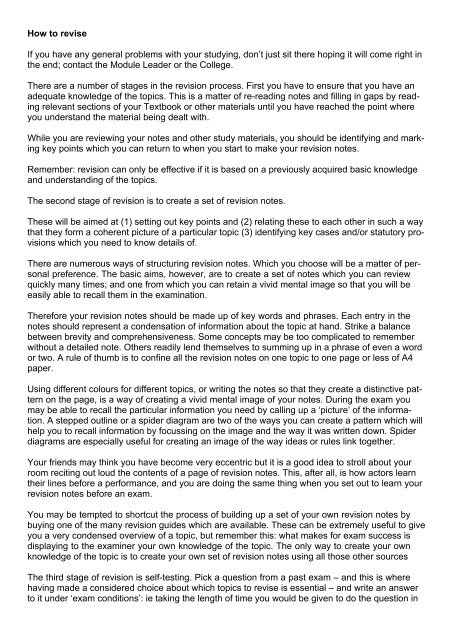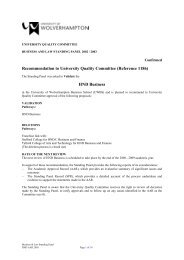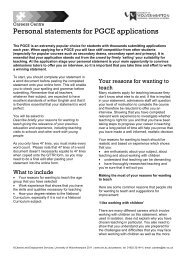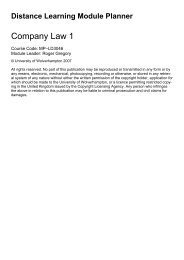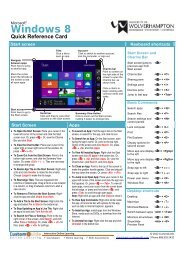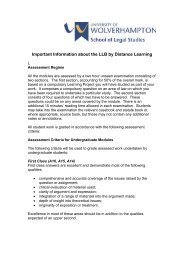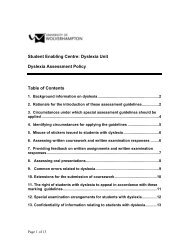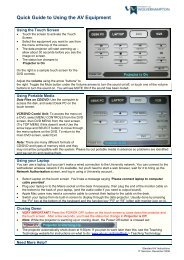Commercial Law: Sale of Goods - University of Wolverhampton
Commercial Law: Sale of Goods - University of Wolverhampton
Commercial Law: Sale of Goods - University of Wolverhampton
Create successful ePaper yourself
Turn your PDF publications into a flip-book with our unique Google optimized e-Paper software.
How to reviseIf you have any general problems with your studying, don’t just sit there hoping it will come right inthe end; contact the Module Leader or the College.There are a number <strong>of</strong> stages in the revision process. First you have to ensure that you have anadequate knowledge <strong>of</strong> the topics. This is a matter <strong>of</strong> re-reading notes and filling in gaps by readingrelevant sections <strong>of</strong> your Textbook or other materials until you have reached the point whereyou understand the material being dealt with.While you are reviewing your notes and other study materials, you should be identifying and markingkey points which you can return to when you start to make your revision notes.Remember: revision can only be effective if it is based on a previously acquired basic knowledgeand understanding <strong>of</strong> the topics.The second stage <strong>of</strong> revision is to create a set <strong>of</strong> revision notes.These will be aimed at (1) setting out key points and (2) relating these to each other in such a waythat they form a coherent picture <strong>of</strong> a particular topic (3) identifying key cases and/or statutory provisionswhich you need to know details <strong>of</strong>.There are numerous ways <strong>of</strong> structuring revision notes. Which you choose will be a matter <strong>of</strong> personalpreference. The basic aims, however, are to create a set <strong>of</strong> notes which you can reviewquickly many times; and one from which you can retain a vivid mental image so that you will beeasily able to recall them in the examination.Therefore your revision notes should be made up <strong>of</strong> key words and phrases. Each entry in thenotes should represent a condensation <strong>of</strong> information about the topic at hand. Strike a balancebetween brevity and comprehensiveness. Some concepts may be too complicated to rememberwithout a detailed note. Others readily lend themselves to summing up in a phrase <strong>of</strong> even a wordor two. A rule <strong>of</strong> thumb is to confine all the revision notes on one topic to one page or less <strong>of</strong> A4paper.Using different colours for different topics, or writing the notes so that they create a distinctive patternon the page, is a way <strong>of</strong> creating a vivid mental image <strong>of</strong> your notes. During the exam youmay be able to recall the particular information you need by calling up a ‘picture’ <strong>of</strong> the information.A stepped outline or a spider diagram are two <strong>of</strong> the ways you can create a pattern which willhelp you to recall information by focussing on the image and the way it was written down. Spiderdiagrams are especially useful for creating an image <strong>of</strong> the way ideas or rules link together.Your friends may think you have become very eccentric but it is a good idea to stroll about yourroom reciting out loud the contents <strong>of</strong> a page <strong>of</strong> revision notes. This, after all, is how actors learntheir lines before a performance, and you are doing the same thing when you set out to learn yourrevision notes before an exam.You may be tempted to shortcut the process <strong>of</strong> building up a set <strong>of</strong> your own revision notes bybuying one <strong>of</strong> the many revision guides which are available. These can be extremely useful to giveyou a very condensed overview <strong>of</strong> a topic, but remember this: what makes for exam success isdisplaying to the examiner your own knowledge <strong>of</strong> the topic. The only way to create your ownknowledge <strong>of</strong> the topic is to create your own set <strong>of</strong> revision notes using all those other sourcesThe third stage <strong>of</strong> revision is self-testing. Pick a question from a past exam – and this is wherehaving made a considered choice about which topics to revise is essential – and write an answerto it under ‘exam conditions’: ie taking the length <strong>of</strong> time you would be given to do the question in


